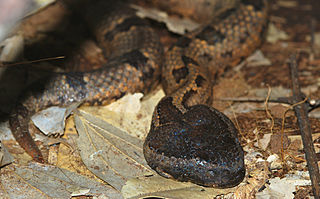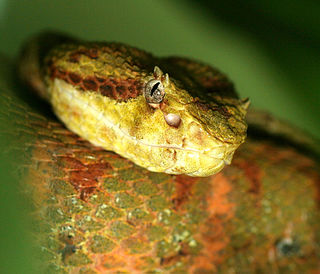The Crotalinae, commonly known as pit vipers, or pit adders, are a subfamily of vipers found in Eurasia and the Americas. Like all other vipers, they are venomous. They are distinguished by the presence of a heat-sensing pit organ located between the eye and the nostril on both sides of the head. Currently, 23 genera and 155 species are recognized: These are also the only viperids found in the Americas. The groups of snakes represented here include rattlesnakes, lanceheads, and Asian pit vipers. The type genus for this subfamily is Crotalus, of which the type species is the timber rattlesnake, C. horridus.

Gloydius is a genus of venomous pitvipers endemic to Asia, also known as Asian moccasins or Asian ground pit vipers. Named after American herpetologist Howard K. Gloyd, this genus is very similar to the North American genus Agkistrodon. 24 species are currently recognized.

Ovophis monticola, commonly known as the Chinese mountain pit viper, is a venomous pitviper species found in Asia. Currently, two subspecies are recognized, including the nominate subspecies described here. Recent taxonomic work suggests that most of these should be considered as separate species. IUCN has already evaluated O. m. makazayazaya as Ovophis makazayazaya.

Trimeresurus albolabris, the white-lipped pit viper or white-lipped tree viper, is a venomous pit viper species endemic to Southeast Asia.
Trimeresurus cantori, commonly known as Cantor's pit viper or Cantor's pitviper, is a species of venomous snake, a pit viper in the Subfamily Crotalinae of the family Viperidae. The species is endemic to the Nicobar Islands of India. It was named after Theodore Edward Cantor (1809-1860), a Danish naturalist serving as a surgeon with the East India Company in Calcutta. No subspecies are recognized as being valid.

Trimeresurus popeiorum is a species of venomous pit viper in the family Viperidae. The species is native to northern and northeastern parts of India and Southeast Asia. Common names include: Pope's pit viper, Pope's green pit viper, Pope's tree viper and Pope's bamboo pitviper.

Trimeresurus stejnegeri is a species of venomous pit viper endemic to Asia. Two subspecies are currently recognized, including the nominate subspecies described here.

Protobothrops sieversorum, commonly known as the three horned-scaled pitviper or the three-horn-scaled pit-viper, is a species of venomous snake, a pit viper in the family Viperidae. The species is endemic to Vietnam.

Protobothrops mangshanensis, commonly known as the Mangshan pit viper, Mangshan pitviper, Mt. Mang pitviper, or Mang Mountain pitviper, is a venomous pit viper species endemic to Hunan and Guangdong provinces in China. No subspecies are currently recognized. This is a nocturnal pit viper that is also known as the ''Mangshan iron-head snake'', ''Chinese pit viper'', and the ''Ironhead viper''. They eat frogs, birds, insects, and small mammals. They have a white tail tip that they wiggle to mimic a grub so that prey comes into striking range—a behaviour known as caudal luring. The venom causes blood clotting and corrodes muscle tissue and can be fatal to humans if not treated. Unusually for vipers, P. mangshanensis is oviparous with the female laying clutches of 13–21 eggs which she will guard until they hatch.

Gloydius halys is a venomous pitviper species found within a wide range that stretches across Asia, from Russia, east of the Urals, eastwards through China. Five subspecies are currently recognized, including the nominotypical form described here.

Craspedocephalus trigonocephalus, the Sri Lankan pit viper, Ceylon pit viper, Sri Lankan green pitviper or locally, pala polonga, is a venomous pit viper species endemic to Sri Lanka. No subspecies are currently recognized.
Protobothrops kaulbacki, commonly known as the Kaulback's lance-headed pitviper or Kaulback's lance-headed pit viper, is a venomous pit viper species endemic to Asia. No subspecies are currently recognized.

Gloydius intermedius is a venomous pitviper species endemic to northern Asia. Three subspecies are currently recognized, including the nominate subspecies described here.
Gloydius shedaoensis is a venomous pitviper species found only on Shedao Island in China. Although very small, this island is home to an extraordinarily large population of these snakes. No subspecies are currently recognized.
Gloydius strauchi is a species of venomous pit viper in the subfamily Crotalinae of the family Viperidae. The species is native to western China. It is a small snake with a pattern of four longitudinal stripes, although some older specimens may be a uniform black. G. strauchi may be distinguished from G. monticola by its higher midbody dorsal scale count. This species jointly holds the altitude record for pitvipers together with Crotalus triseriatus of Mexico, both being found even above the tree line at over 4,000 m (13,000 ft). No subspecies were recognized as being valid, until a recent publication re-evaluated the taxonomic statuses of populations of G. strauchi and described the eastern Tibetan populations as a new species.

Bothriechis supraciliaris, commonly known as the blotched palm-pit viper, is a species of venomous snake in the subfamily Crotalinae of the family Viperidae. The species is endemic to southern pacific parts of Talamanca Mountain Range in Costa Rica and western Panama. No subspecies are recognized.
Ophryacus smaragdinus is a venomous pitviper species endemic to the mountains of eastern Mexico. No subspecies are currently recognized.

Trimeresurus salazar, also known as Salazar's pit viper, is a species of venomous, green pit viper first discovered in 2019 in the lowlands of the western part of Arunachal Pradesh, India; the fifth new reptile species to be discovered in the region in 2019. It was named after Salazar Slytherin from the Harry Potter series. It has a dark green head and yellowish green dorsal scales on the rest of its body. The species is sexually dichromatic; the males have reddish-orange and yellow-orange stripes and a rusty red-orange tail that the females lack. Its habitat is under threat from human development activities.
Trimeresurus sichuanensis is a species of pit viper found in Sichuan, China.
Gloydius chambensis, the Chamba pitviper, is a species of venomous snake belonging to the family Viperidae and the subfamily Crotalinae, the pit vipers. It was described in 2022 from the Chamba District of Himachal Pradesh in the southern Himalayas of northern India. It was identified as a separate species from Gloydius himalayanus by genetic differences and by differences in the counts of scales in some tracts.











